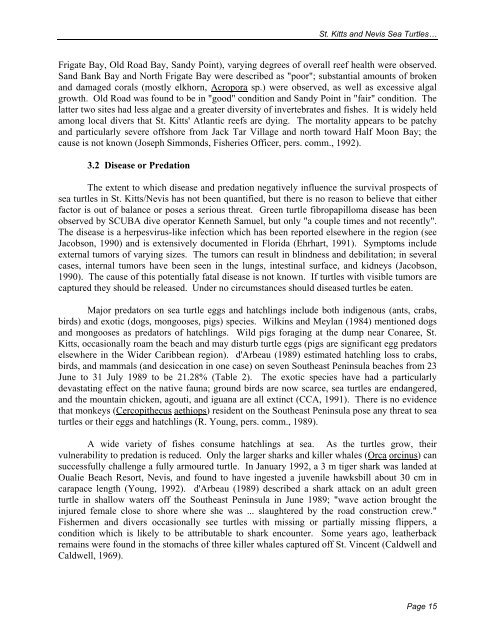Sea Turtle Recovery Action Plan for St. Kitts and Nevis - WIDECAST
Sea Turtle Recovery Action Plan for St. Kitts and Nevis - WIDECAST
Sea Turtle Recovery Action Plan for St. Kitts and Nevis - WIDECAST
You also want an ePaper? Increase the reach of your titles
YUMPU automatically turns print PDFs into web optimized ePapers that Google loves.
<strong>St</strong>. <strong>Kitts</strong> <strong>and</strong> <strong>Nevis</strong> <strong>Sea</strong> <strong>Turtle</strong>s…<br />
Frigate Bay, Old Road Bay, S<strong>and</strong>y Point), varying degrees of overall reef health were observed.<br />
S<strong>and</strong> Bank Bay <strong>and</strong> North Frigate Bay were described as "poor"; substantial amounts of broken<br />
<strong>and</strong> damaged corals (mostly elkhorn, Acropora sp.) were observed, as well as excessive algal<br />
growth. Old Road was found to be in "good" condition <strong>and</strong> S<strong>and</strong>y Point in "fair" condition. The<br />
latter two sites had less algae <strong>and</strong> a greater diversity of invertebrates <strong>and</strong> fishes. It is widely held<br />
among local divers that <strong>St</strong>. <strong>Kitts</strong>' Atlantic reefs are dying. The mortality appears to be patchy<br />
<strong>and</strong> particularly severe offshore from Jack Tar Village <strong>and</strong> north toward Half Moon Bay; the<br />
cause is not known (Joseph Simmonds, Fisheries Officer, pers. comm., 1992).<br />
3.2 Disease or Predation<br />
The extent to which disease <strong>and</strong> predation negatively influence the survival prospects of<br />
sea turtles in <strong>St</strong>. <strong>Kitts</strong>/<strong>Nevis</strong> has not been quantified, but there is no reason to believe that either<br />
factor is out of balance or poses a serious threat. Green turtle fibropapilloma disease has been<br />
observed by SCUBA dive operator Kenneth Samuel, but only "a couple times <strong>and</strong> not recently".<br />
The disease is a herpesvirus-like infection which has been reported elsewhere in the region (see<br />
Jacobson, 1990) <strong>and</strong> is extensively documented in Florida (Ehrhart, 1991). Symptoms include<br />
external tumors of varying sizes. The tumors can result in blindness <strong>and</strong> debilitation; in several<br />
cases, internal tumors have been seen in the lungs, intestinal surface, <strong>and</strong> kidneys (Jacobson,<br />
1990). The cause of this potentially fatal disease is not known. If turtles with visible tumors are<br />
captured they should be released. Under no circumstances should diseased turtles be eaten.<br />
Major predators on sea turtle eggs <strong>and</strong> hatchlings include both indigenous (ants, crabs,<br />
birds) <strong>and</strong> exotic (dogs, mongooses, pigs) species. Wilkins <strong>and</strong> Meylan (1984) mentioned dogs<br />
<strong>and</strong> mongooses as predators of hatchlings. Wild pigs <strong>for</strong>aging at the dump near Conaree, <strong>St</strong>.<br />
<strong>Kitts</strong>, occasionally roam the beach <strong>and</strong> may disturb turtle eggs (pigs are significant egg predators<br />
elsewhere in the Wider Caribbean region). d'Arbeau (1989) estimated hatchling loss to crabs,<br />
birds, <strong>and</strong> mammals (<strong>and</strong> desiccation in one case) on seven Southeast Peninsula beaches from 23<br />
June to 31 July 1989 to be 21.28% (Table 2). The exotic species have had a particularly<br />
devastating effect on the native fauna; ground birds are now scarce, sea turtles are endangered,<br />
<strong>and</strong> the mountain chicken, agouti, <strong>and</strong> iguana are all extinct (CCA, 1991). There is no evidence<br />
that monkeys (Cercopithecus aethiops) resident on the Southeast Peninsula pose any threat to sea<br />
turtles or their eggs <strong>and</strong> hatchlings (R. Young, pers. comm., 1989).<br />
A wide variety of fishes consume hatchlings at sea. As the turtles grow, their<br />
vulnerability to predation is reduced. Only the larger sharks <strong>and</strong> killer whales (Orca orcinus) can<br />
successfully challenge a fully armoured turtle. In January 1992, a 3 m tiger shark was l<strong>and</strong>ed at<br />
Oualie Beach Resort, <strong>Nevis</strong>, <strong>and</strong> found to have ingested a juvenile hawksbill about 30 cm in<br />
carapace length (Young, 1992). d'Arbeau (1989) described a shark attack on an adult green<br />
turtle in shallow waters off the Southeast Peninsula in June 1989; "wave action brought the<br />
injured female close to shore where she was ... slaughtered by the road construction crew."<br />
Fishermen <strong>and</strong> divers occasionally see turtles with missing or partially missing flippers, a<br />
condition which is likely to be attributable to shark encounter. Some years ago, leatherback<br />
remains were found in the stomachs of three killer whales captured off <strong>St</strong>. Vincent (Caldwell <strong>and</strong><br />
Caldwell, 1969).<br />
Page 15
















